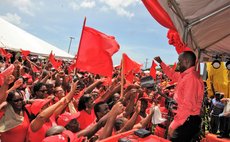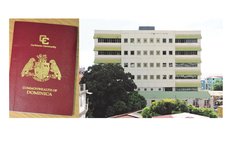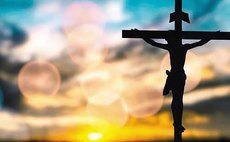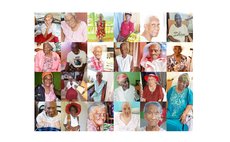May 29 1979, is one of Dominica's most significant dates
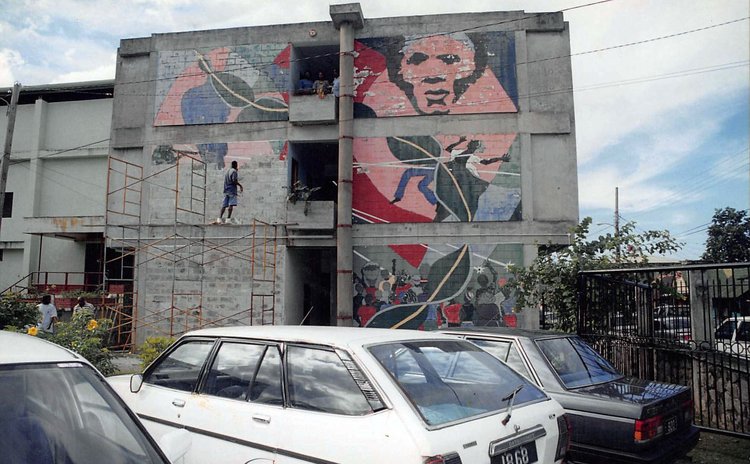
"Those who cannot remember the past are condemned to repeat it"-Philosopher George Santayana.
To understand the significance of May 29, read the words of two of Dominica's foremost historians, Dr Irving André and the late Dr William "Para" Riviere.
"It rained later that day; a steady persistent downpour that washed the blood- stained streets and dispersed the crowds which had gathered on the streets earlier before," writes Dr André in his book "The Rise and Fall of Patrick Roland John" about May 29, 1979, the riots that occurred just six months after Dominica gained independence from Britain.
Dr Andre continued, "In the vicinity of the Ministry stones on the roads served as grim reminders of what had transpired before while the smell of cordite hovered over the scene, many gripped by anger over what they had witnessed."
What "they had witnessed" was the shooting of unarmed protesters by the army and police of the Labour Party Administration of Patrick John on May 29, 1979.
One young man, Phillip Timothy, died.
In less than two weeks, on Monday, May 29, Dominicans must remember the 44th anniversary of this appalling day, a day that changed the trajectory of the future of Dominica; a day that Dominicans should try not to repeat; a day that could reoccur if we continue to forget the lessons of history if we continue to ignore the demands of the people; if we continue to ignite the flames of political divisiveness, if we continue to dismantle, covertly and overtly, the very foundations of our fledgling democracy.
Because according to philosopher George Santayana: "Those who cannot remember the past are condemned to repeat it". Unfortunately, to commemorate May 29, there will be no symposiums or conferences, no marches or walks in the streets of the city or the villages, no speeches or statements in the press, and no prayers or vigils in the churches. Nothing, silence.
Politicians have programmed Dominicans to forget, be numb to their history, remain mum in the face of outrage, ignore the obvious, and say down is up and up is down.
Only Charles Savarin is alive among the main ringleaders of the May 29, 1979 riots. Dame Eugenia, the prime minister, and Louis "Zarbocka" Benoit, the union leader, are dead. But, remarkably, Charles Savarin is not only very much alive but also Dominica's President. There is no better example of truth being stranger than fiction.
May 29, 1979, is one of the most significant dates in the short history of Dominica. Yet many need to remember that date and consider its significance when it comes around. May 29, 1979, is as momentous an occasion as Independence Day, Emancipation Day, the devastation of Dominica by Hurricane David on August 29, 1979, and the billion-dollar damage-causing Hurricane Maria on September 18, 2017.
Anthony Astaphan SC, the éminence grise of the current ruling Dominica Labour Party regime, has called the revolution a "kool wosh brigade" because the rioters used stones and bottles to pelt at their tormenters. However, May 29 was much more than throwing stones.
Dominica's current economic and social conditions and the period leading up to the civil unrest of May 29, 1979, are so similar that some commentators have predicted that history may be about to repeat itself. We may be wrong, but we doubt Dominicans can come together again as they did in 1979 to overthrow an extremely unpopular government, even if the economic conditions are similar today. There are no more people like Charles Angelo Savarin (of the 70s) and Dame Eugenia Charles of the Dominica Freedom Party.
In a series of essays on the riots (published in the Sun in 2016), Historian Dr William "Para" Riviere agrees that "the ousting of the John regime was rooted substantially in the economic circumstances of the island. Internal self-government, labelled Associate Statehood, had been granted by the Colonial Power in 1967, leaving the island, except for grant-in-aid, to paddle its own canoe … A conspiracy of forces would plunge the island's economy into a crisis --- the 1974 Budget Debate in Parliament called upon the already hard-pressed public to bear an additional burden of taxation --- neither the State sector nor the co-operative or private sectors advanced --- Productive capacity slackened, if not stagnated --- unemployment and underemployment escalated".
Strapped for cash, the government of Patrick John turned to apartheid South Africa, the establishment of a pseudo-free port zone in Portsmouth conceived by Texas businessman Don Pierson, and undertook other questionable capital ventures.
As the population endured that dreadful economy, the government further risked confrontation with the militant trade unions by enacting the Industrial Relations (Amendment) Act and the Prohibited and Unlawful Societies and Association Act (The Dread Act).
But what are the lessons we can learn from May 29, 1979? It is that the struggle for freedom and democracy continues.
"The greatest lesson we can learn from the past . . . is that freedom is at the core of every successful nation in the world," said Frederick Chiluba, the first democratically elected president of Zambia.
